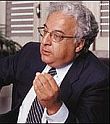
|
Link
Consulting, SA
  Biography Biography
Dr. José Tribolet (PhD from MIT). He is Full Professor
of Information Systems, at the
Department of Computer Science of IST/Technical University
of Lisbon. He is President of
INESC - Institute for Systems and Computer Engineering,
one of the top research institutes
of Portugal. Previously he was a Visiting Scientist in
ATT Bell Laboratories (NJ, USA), and
NTT Basic Research Laboratories (Tokyo, Japan). He spent
a sabbatical year (97/98) as
Visiting Sloan Fellow, at the Sloan School of Management,
MIT, Cambridge, MA, USA,
where he joined the Center for Coordination Sciences, leaded
by Prof. Thomas Malone.
Upon his return to Portugal he created the Center for Organizational
Engineering (CEO).
Since then he has published several papers on Organizational
Engineering with his graduate
students, as part of the ongoing research efforts in this
field. He proposed and has promoted
with success a new Special Track on Organization Engineering
at the 19th ACM-SAC -
Symposium on Applied Computing, in Nycosia, Cyprus, in
2004. This track which will occur
again, enlarged to two sessions, in 2005, at the 20th ACM-SAC
in Santa Fe, New Mexico. |
  Biography Biography
Dr. Pedro Sousa (PhD) is an Associate Professor at Technical University of
Lisbon, where he teaches a course on the Information Systems planning and
Architecture based on the Zachman Framework. He is also a researcher at Organizational
Engineering group (CEO), where he has 18 articles and presentations on subject
of Enterprise Architectures (for example at ZIFA Forum 2003). He is also
a senior consultant of Link Consulting (www.link.pt), where has been involved
in 16 professional projects on Enterprise Architectures both in private and
public sector for the past seven years. |
 Presentation
Presentation
The Enterprise Architecture of a Large Portuguese
Public Hospital
This presentation aims to report an ongoing Enterprise Architecture
project at HUC -
Hospitais Universitários de Coimbra, the biggest Portuguese
public health care institution,
with over 5000 employees (doctors, nurses, technicians). We
will present the organization
reality before and after our intervention, the methodology
used, and the major results
obtained so far, as perceived by the organization.
Given the high pressure from the government to reduce
funding and increase ROI, the initial goal of the project
was to respond to CEO willingness to establish, on solid
grounds, new reasoning about HUC processes, quality improvement,
operational results, and strategic
guidelines.
Using Zachman Framework as
the basis for the design of HUC´s
Enterprise Architecture,
teams of doctors, nurses and administrative staff have
been developing descriptions of the
organization. Until now, 10 out of 43 hospital divisions
have been involved in the first phase
of HUC´s Enterprise Architecture project. One of
such divisions, the Emergency Service,
had its facilities greatly expanded and re-equipped for
UEFA Euro 2004 event, which led to
the reengineering of its operational processes, as the
EA project was being developed.
Our goal, one year from now, is to have a dynamic As-Is
representation of the entire
Hospital, involving all of its 43 divisions, and from there,
to continuously address both
reengineering process and I/S architecture challenges,
while maintaining organizational
coherence and integrity.
Key topics
- Organization Reality (Before the Project)
- The Importance of Enterprise Architecture and Organizational
Engineering
- Information Governance Concept
- Methodology Used
- Problem Oriented using the
Zachman Framework
- Workgroup driven, in each division involved representatives
of the
various professional classes (Doctors, Nurses, Pharmaceuticals,
Clinical Secretaries, Technicians))
- Results (Organization Reality After the Project)
- Future
Work
 return
to program return
to program |
|
|